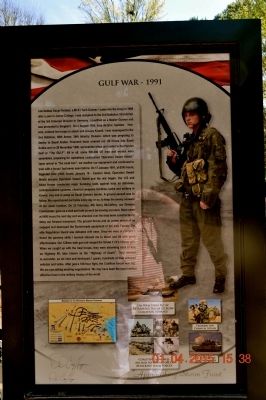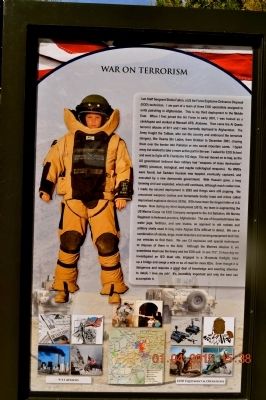Huntsville in Madison County, Alabama — The American South (East South Central)
Gulf War-1991/War on Terrorism
Gulf War-1991
I am Nathan Oscar Pardner, a M1A1 Tank Gunner. I came into the Army in 1988 after a year in Junior College. I was assigned to the 2nd Battalion 33rd Armor of the 3rd Armored Division in Germany. I qualified as a Master Gunner and was promoted to Sergeant. On August 1990, Iraqi dictator, Saddam Hussein, ordered his troops to attack and occupy Kuwait. I was reassigned to the 2nd Battalion, 69th Armor, 24th Infantry Division, which was preparing to deploy to Saudi Arabia. President Bush ordered our US forces into Saudi Arabia and on 28 November 1990, we boarded ships and sailed to the Persian Gulf or “The GULF”. All in all, some 500,000 US men and women were assembled, preparing for operations codenamed ‘Operation Desert Shield.” Upon arrival in “the sand box”, we readied our equipment and continued to train with a focus I had never seen before. On 17 January 1991, at 0245 hours, Baghdad time (1845 hours, January 16 - Eastern time), Operation Desert Shield became Operation Desert Storm and the war began. Our U.S and Allied forces conducted major bombing raids against Iraqi air defenses, communications systems, chemical weapons facilities, tanks and artillery in Kuwait, Iraq and in areas on Saudi Arabia’s border. A ground assault was to follow. We repositioned our tanks every day or so, to keep the enemy unaware of our exact location. On 23 February, MG Barry McCaffery, our Division Commander, gave us a visit and told us we’d be moving out soon. Soon came at 0400 hours the next day and we attacked over the Iraqi berm constructed to delay our forward movement. The ground forces and air power ahead of us engaged and destroyed the Soviet-made equipment of the Iraqi Forces. The elite Republican Guard was defeated with ease. Once we were in contact, I found the gunnery skills I learned allowed me to shoot and hit with great effectiveness. Our 120mm tank gun out-ranged the Soviet T-72’s 125mm gun. When we caught up with the Iraqi troops, they were streaming back to Iraq on Highway 80, later known as the “Highway of Death”. They refused to surrender, so we shot and destroyed, I guess, hundreds of their armored vehicles and tanks. After just a 100-hour fight, the Coalition forces won big. We are now sitting awaiting negotiations. We may have been the most combat effective force in the military history of the world.
(side 2)
War on Terrorism
I am Staff Sergeant Shelia Fallon, a US Air Force Explosive Ordnance Disposal (EOD) technician. I am part of a team of three EOD specialists assigned to units patrolling in Afghanistan. This is my third deployment to the Middle East. When I first joined the Air Force in early 2001, I was trained as clerk/typist and worked at Maxwell AFB, Alabama. Then came the Al Qadea terrorist attacks of 9/11 and I was hurriedly deployed to Afghanistan. The Army fought the Taliban, who ran the country and embraced the terrorists (tangos), like Osama Bin Laden, from October to December 2001, chasing them over the border into Pakistan or into secret mountain caves. I typed away but wished to take a more active part in the war. I ask for EOD School and went to Eglin AFB, Florida for 162 days. The war moved on to Iraq, as the US government believed their military had “weapons of mass destruction” (WMD) (chemical, biological, and maybe radiological weapons). No WMDs were found, but Saddam Hussein was toppled, eventually captured, and executed by a new democratic government. With Hussein gone, a long brewing civil war exploded, which still continues, although much cooler now. I made my second deployment in 2003 and things were still popping. We uncovered weapons caches and homemade booby traps and mines called improvised explosive devices (IEDs). IEDs have been the largest killer of U.S. troops. Now during my third deployment (2013), my team is augmenting the US Marine Corps 1st EOD Company assigned to the 3rd Battalion, 6th Marine Regiment in Helmand province, Afghanistan. The use of household items like water jugs, fertilizer, and saw blades, as opposed to old rockets and artillery shells used in Iraq, make Afghan IEDs difficult to detect. We use a combination of robots, dogs, metal detectors and sensing equipment built into our vehicles to find them. We use C4 explosive and special techniques to dispose of them in the field. Although the Marines despise it, we sometimes must use the heavy and hot EOD suit. In one 115°, 12-hour day we investigated an IED blast site, engaged in a 30-minute firefight, blew up a bridge and swept a mile or so of road for more IEDs. Even though it is dangerous and requires a great deal of knowledge and exacting attention to detail, I love my job! It’s incredibly important and only the best can accomplish it.
Topics and series. This memorial is listed in this topic list: War, 1st Iraq & Desert Storm. In addition, it is included in the Former U.S. Presidents: #41 George H.W. Bush series list. A significant historical date for this entry is January 17, 1991.
Location. 34° 44.107′ N, 86° 35.324′ W. Marker is in Huntsville, Alabama, in Madison County. Memorial can be reached from the intersection of Monroe Street Northwest and Jefferson Street North, on the left when traveling east. In Veterans Memorial Park along the Patriots Walkway near the five points ditch. Touch for map. Marker is at or near this postal address: 200 Monroe Street Northwest, Huntsville AL 35801, United States of America. Touch for directions.
Other nearby markers. At least 8 other markers are within walking distance of this marker. 1959-1975/Vietnam War/Vietnam War (here, next to this marker); Cold War-Global 1945-/ Cold War-Germany 1945-1990 (here, next to this marker); Korean War/1950-1953 (here, next to this marker); Korean War / Cold War-Korea 1953- (here, next to this marker); World War II - European Theater of Operations (ETO) (here, next to this marker); ETO 1939-1945/PTO 1941-1945 (a few steps from this marker); Spanish American War 1898/Philippine Insurrection 1899-1913 (a few steps from this marker); World War II - Pacific Theater of Operations (PTO) (a few steps from this marker). Touch for a list and map of all markers in Huntsville.
Also see . . . Huntsville Madison County Veterans Memorial. (Submitted on April 17, 2015.)
Credits. This page was last revised on June 16, 2016. It was originally submitted on April 16, 2015, by Sandra Hughes Tidwell of Killen, Alabama, USA. This page has been viewed 469 times since then and 19 times this year. Last updated on July 15, 2015, by J. Makali Bruton of Accra, Ghana. Photos: 1, 2. submitted on April 16, 2015, by Sandra Hughes Tidwell of Killen, Alabama, USA. • Bill Pfingsten was the editor who published this page.

